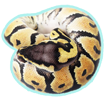» Site Navigation

0 members and 630 guests
No Members online
Most users ever online was 47,180, 07-16-2025 at 05:30 PM.
» Today's Birthdays

» Stats

Members: 75,916
Threads: 249,118
Posts: 2,572,201
Top Poster: JLC (31,651)
|
-
Registered User


I've been reading this thread, but I haven't voiced my opinions because I don't want to be giving out information that is not necessarily mine to give out, that and I am very new to the community and don't expect people to necessarily believe me. I am not going to name any names or sources in order to keep confidentiality, so you can believe what I have to say or disregard it, but I fully believe that this information is true and comes from a reliable source.
Now that the disclaimer is out there...
I spoke with someone recently about spiders and spider wobble. This person is not new to the BP business by any means. The person I spoke with has a homozygous spider. I did not ask much about it, whether he bred it, etc, but he told me that it looks like a reduced spider. He also mentioned that it has an awful wobble; it is a male.
***BUT IT IS NOT HOMOZYGOUS LETHAL***
He said that he does NOT believe that the awful wobble is because it is a 'lethal' combination. He fully believes that it is because the spider was so heavily inbred early on that the animal is the way it is because of serious inbreeding and not because it is a homozygous spider. It is also an older animal, so it was produced before the spider was really outcrossed.
He does not believe that the wobble and spider are inseparable. He among some others believe that the spider wobble generated at the earliest stages of the morph development. When they were first brought over, they were so heavily inbred (spider to spider) that some developed a serious wobble. Now that they are being outcrossed, you are seeing spiders/combos that have little to no apparent wobble.
The theory that the genes sit close to each other on the genetic ladder implies that it is harder to separate right at the cutoff from other deformities. This is a possible explanation for why it has taken so much outcrossing to see spiders without wobble.
I know people VEHEMENTLY believe that 100% of all spiders/combos have wobble. He does not believe this (nor do I.) I think MOST spiders carry wobble to some degree, maybe even 95%+, but I believe there are some out there without it. I have seen a spider with no visible wobble (and I've tried all the 'tricks' to get it to do so) I have also seen spiders/combos with significant wobble or at least *some* wobble (this is more often than not.)
I am not saying there are a lot of spiders that don't wobble, or that it will be easy to eradicate wobble from the spider ball pythons. I just believe that it is possible to separate the two.
***
Anyways, I'm not trying to start any arguments, I simply wanted to share the information that I had acquired. I don't see any reason to keep it a secret, but if people ARE keeping it a secret for some reason, I didn't want to name names or give out specific information.
My only thoughts are that, there are no/very few homozygous spiders that aren't showing signs of heavy inbreeding and they are waiting to produce one that they are comfortable showing to the public. There is something preventing the spider to be free from the wobble (whether it be because the genes lie close together or whatever other reason) but I believe that this is why it has taken so long to see spiders with less wobble.
Last edited by sungmina; 10-18-2010 at 05:59 PM.
mina
1.0 bee
0.1 lesser 0.2 normal
1.1.2 r. chahoua
3.6.0 r. ciliatus
1.1.1 r. leachianus
-
 Posting Permissions
Posting Permissions
- You may not post new threads
- You may not post replies
- You may not post attachments
- You may not edit your posts
-
Forum Rules
|










 Reply With Quote
Reply With Quote